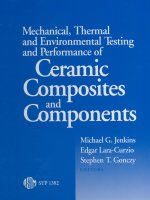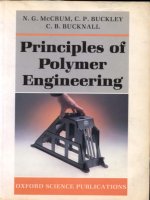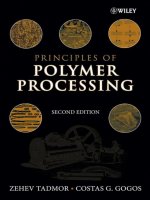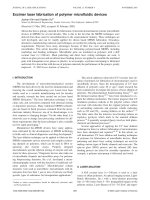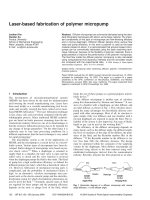Manufacturing of polymer composites
Bạn đang xem bản rút gọn của tài liệu. Xem và tải ngay bản đầy đủ của tài liệu tại đây (28.38 MB, 500 trang )
B.T. Astrom Aw
Manufacturing
| F : : ee ees eee ee ee ee e ne ee
4 de eet ees ee te! Sy 2 fee e1
52
Manufacturing of
Polymer Composites
To Carol and Sara, who each in their own way made this book possible
Manufacturing of
Polymer Composites
B. T. Astrém
Department of Aeronautics
Royal Institute of Technology
Stockholm
Sweden
Gi CHAPMAN & HALL
London - Weinheim - New York - Tokyo - Melbourne - Madras
Published by
Chapman & Hall, 2-6 Boundary Row, London SE1 8HN, UK
Chapman & Hall, 2-6 Boundary Row, London SE1 8HN, UK
Chapman & Hall GmbH, Pappelallee 3, 69469 Weinheim, Germany
Chapman & Hall USA, 115 Fifth Avenue, New York, NY 10003, USA
Chapman & Hall Japan, ITP-Japan, Kyowa Building, 3F, 2-2-1
Hirakawacho, Chiyoda-ku, Tokyo 102, Japan
Chapman & Hall Australia, 102 Dodds Street, South Melbourne, Victoria
3205, Australia
Chapman & Hall India, R. Seshadri, 32 Second Main Road, CIT East,
Madras 600 035, India
First edition 1997
© 1997 B. Tomas Astrém
Typeset in 10/12 pt Palatino by GreenGate Publishing Services,
Tonbridge, Kent.
Printed in Great Britain by St Edmundsbury Press, Bury St Edmunds,
Suffolk
ISBN 0 412 81960 0
Apart from any fair dealing for the purposes of research or private study, or
criticism or review, as permitted under the UK Copyright Designs and
Patents Act, 1988, this publication may not be reproduced, stored, or
transmitted, in any form or by any means, without the prior permission in
writing of the publishers, or in the case of reprographic reproduction only
in accordance with the terms of the licences issued by the Copyright
Licensing Agency in the UK, or in accordance with the terms of licences
issued by the appropriate Reproduction Rights Organization outside the
UK. Enquiries concerning reproduction outside the terms stated here
should be sent to the publishers at the London address printed on this page.
The publisher makes no representation, express or implied, with regard
to the accuracy of the information contained in this book and cannot accept
any legal responsibility or liability for any errors or omissions that may be
made.
A catalogue record for this book is available from the British Library
Printed on acid-free text paper, manufactured in accordance with
ANSI/NISO Z39.48-1992 (Permanence of Paper).
CONTENTS
Preface
Acknowledgements
Nomenclature
Abbreviations and Acronyms
1 INTRODUCTION
1.1 The Evolution of Materials
1.2 The Composite Concept
1.3 Design and Manufacturing
1.4 Market
1.5 Application Examples
1.5.1 Transportation Applications
1.5.2 Marine Applications
1.5.3. Aerospace and Military Applications
1.5.4 Construction Applications
1.5.5 Electrical and Sanitary Applications
1.5.6 Sports Applications
1.5.7 Other Applications
1.6 Book Contents
1.7 Outlook
1.8 Summary
References
2 CONSTITUENT MATERIALS
2.1 Matrices
2.1.1 Polymer Morphology
2.1.2 Structural Aspects Influencing Properties
2.1.2.1 Intramer Structure
2.1.2.2 Intramolecular Structure
2.1.2.3 Intermolecular Structure
2.1.3 Polymer Properties
2.1.3.1 Thermal Properties of Solid Polymers
2.1.3.2 Mechanical Properties of Solid Polymers
2.1.3.3 Other Properties of Solid Polymers
2.1.3.4 Properties of Liquid Polymers
2.1.3.5 Healing of Polymers
2.1.3.6 Liquid Crystalline Polymers
vi Contents
2.1.3.7 Elastomers Types
2.1.4 Polymers as Composite Matrices
2.1.5 Thermoplastic Polymer Matrices
2.1.5.1 Polyethylenes
2.1.5.2 Polypropylenes
2.1.5.3 Polyamides
2.1.5.4 Thermoplastic Polyesters
2.1.5.5 Poly(phenylene Sulfides)
2.1.5.6 Polyketones
2.1.5.7 Polysulfones
2.1.5.8 Thermoplastic Polyimides
2.1.6 Thermoset Polymer Matrices
2.1.6.1 Unsaturated Polyesters
2.1.6.2 Epoxies
2.1.6.3 Vinylesters
2.1.6.4 Phenolics
2.1.6.5 Other Thermosets
2.1.7 Matrix Forms
2.1.8 Additives
2.2 Reinforcements
2.2.1 Glass Fibers
2.2.2 Carbon Fibers
2.2.3 Aramid Fibers
2.2.4 Polyethylene Fibers
2.2.5 Other Fibers
2.2.6 Reinforcement—Matrix Interaction
2.2.7 Fibrous Reinforcement Forms
2.2.7.1 Weaving
2.2.7.2. Noncrimp Fabrics
2.2.7.3 Knitting
2.2.7.4 Braiding
2.2.7.5 Mats and Non-Wovens
2.2.7.6 Combination Fabrics and Preforms
2.3 Preimpregnated Reinforcement
2.3.1 Solvent Impregnation
2.3.2 Melt Impregnation
2.3.3 Powder Impregnation
2.3.4 Commingling
2.3.5 Comparison of Preimpregnated Reinforcement
2.3.6 Molding Compounds
2.4 Core Materials
2.4.1 Wood Cores
2.4.2 Honeycomb and Corrugated Cores
2.4.3 Expanded Foam Cores
2.5 Adhesives Contents vii
2.6 Composites Based on Inorganic Matrices
129
2.6.1 Carbon—Carbon Composites 131
2.6.2 Metal—Matrix Composites 131
2.6.3 Ceramic—Matrix Composites
2.7 Summary 204
Suggested Further Reading
References
PROPERTIES
3.1 Matrices
3.1.1 Thermal Properties
3.1.2 Mechanical Properties
3.2 Reinforcements
3.2.1 Thermal Properties
3.2.2 Mechanical Properties
3.3. Composites
3.3.1 “Prediction of Thermal Properties
3.3.2 Prediction of Mechanical Properties
3.3.3 Comparisons of Predicted Mechanical Properties
3.3.4 Experimentally Determined Thermal Properties
3.3.5 Experimentally Determined Mechanical Properties
3.4 Core Materials
3.5 Sandwich Components
3.6 Summary
Suggested Further Reading
References
MANUFACTURING TECHNIQUES
4.1 Generic Manufacturing-related Issues
4.1.1 Mold Fabrication
4.1.1.1 Direct Manual Mold Fabrication
4.1.1.2 Mold Fabrication Using a Master Model
4.1.1.3 Mold Fabrication through Direct Machining
4.1.1.4 Flexible Molds
4.1.2 Reinforcement Conformability
4.1.3 Prepreg Conformability
4.1.4 Heat Transfer
4.2 Thermoset—Matrix Techniques
4.2.1 Wet Layup
4.2.1.1 Hand Layup
4.2.1.2 Spray-up
4.2.1.3 Hand Layup of Sandwich Components
viii Contents
4.2.2 Prepreg Layup
4.2.3. Liquid Molding
4.2.3.1 Injection Molding
4.2.3.2 Resin Transfer Molding
4.2.3.3. Vacuum Injection Molding
4.2.3.4 Reaction Injection Molding
4.2.3.5 Reinforced Reaction Injection Molding
4.2.3.6 Structural Reaction Injection Molding
4.2.4 Compression Molding
4.2.5 Filament Winding
4.2.6 Pultrusion
4.2.7 Other Techniques
4.3 Thermoplastic—-Matrix Techniques
4.3.1 Prepreg Layup
4.3.2 Liquid Molding
4.3.3 Compression Molding
4.3.3.1 Compression Molding of GMT
4.3.3.2 Compression Molding of Prepregs and Flat Laminates
4.3.4 Filament Winding
4.3.5 Pultrusion
4.3.6 Diaphragm Forming
4.3.7 Other Techniques
4.4 Manufacturing-induced Component Defects
4.4.1 Structural Defects
4.4.1.1 Deviations in Reinforcement Orientation and Content
4.4.1.2 Voids
4.4.1.3 Incomplete Impregnation and Mold Filling
4.4.1.4 Variations in Constituent Properties
4.4.2 Geometrical Defects
4.4.3 Cosmetic Defects
4.5 Summary
Suggested Further Reading
References
5 SECONDARY PROCESSING
5.1 Machining
5.1.1 Conventional Cutting Techniques
5.1.1.1 Drilling
5.1.1.2 Sawing
5.1.1.3 Edge Trimming
5.1.1.4 Other Cutting Operations
5.1.2. Waterjet Machining
5.1.3 Laser Machining
5.1.4 Other Machining Techniques Contents ix
5.2 Joining
325
5.2.1 Mechanical Joining 326
5.2.2 Adhesive Joining 326
5.2.3. Cocuring and Lamination 330
5.2.4 Fusion Bonding 334
335
5.2.5 Solvent Bonding 336
5.2.6 Joining of Sandwich Components 337
5.3 Surface Finishing 339
5.4 Repair 340
5.5 Summary 347
348
Suggested Further Reading 348
References
6 QUALITY CONTROL AND CHARACTERIZATION 350
6.1 Constituent Quality Control and Characterization 350
6.2 Composite Characterization 352
6.2.1~ Physical Properties 354
6.2.1.1 Constituent Fractions through Matrix Burn-off 354
6.2.1.2 Constituent Fractions through Matrix Digestion 35D
6.2.1.3 Constituent Fractions through Microscopy 356
6.2.1.4 Void Fraction and Density 358
6.2.2 Mechanical Properties G9
6.2.2.1 Tensile Properties 361
6.2.2.2, Compressive Properties 363
6.2.2.3 Shear Properties 368
6.2.2.4 Flexural Properties 374
6.2.3. Thermal Properties 375
6.3 Composite Quality Control 376
6.3.1 Destructive Testing OLF
6.3.2 Nondestructive Testing 378
6.3.2.1 Visual Inspection 379
6.3.2.2 Ultrasonic Inspection O72
6.3.2.3 Vibrational Inspection 385
6.3.2.4 Radiographic Inspection 385
6.3.2.5 Thermographic Inspection 388
6.3.2.6 Acoustic Emission Inspection 389
6.3.2.7 Eddy-current Inspection 391
6.3.2.8 Optical Inspection 392
6.4 In-service Inspection 393
6.5 Summary 394
Suggested Further Reading 395
References 397
x Contents
7 RECYCLING 398
7.1 Incentives 398
7.2 Infrastructure
7.3. Recycling Techniques
7.3.1 Primary and Secondary Recycling
7.3.1.1 Thermoset Composites
7.3.1.2 Thermoplastic Composites
7.3.2 Tertiary Recycling
7.3.3 Quaternary Recycling
7.4 Market Commitment
7.5 Green Thinking in Design
7.5.1 Design for Minimization of Waste
7.5.2 Design for Recycling
7.5.3 Component Labeling
7.6 Summary
Suggested Further Reading
References
8 HEALTH AND SAFETY
8.1 Terminology
8.2 Routes of Exposure and Harmful Effects
8.3 Protective Measures
8.3.1 Administrative Controls
8.3.2 Engineering Controls
8.3.3 Personal Protective Equipment
8.3.4 First Aid
8.4 Constituent Materials
8.4.1 Matrices, Adhesives, and Solvents
8.4.1.1 Thermoplastics
8.4.1.2 Unsaturated Polyesters and Vinylesters
8.4.1.3 Epoxies
8.4.1.4 Other Thermosets
8.4.1.5 Solvents
8.4.2 Reinforcements and Fillers
8.4.3 Preimpregnated Reinforcement
8.4.4 Core Materials
8.5 Manufacturing Techniques
Soe | Mold and Tool Cleaning
Resin Formulation
Wet Layup
Prepreg Layup
Liquid Molding
Compression Molding
8.5.7 Filament Winding Techniques Contents xi
8.5.8 Pultrusion
8.5.9 Thermoplastic—Matrix 442
8.6 Machining 443
8.7 Summary 443
Disclaimer 443
444
Suggested Further Reading 446
References 446
446
Index
449
Disclaimer
While every effort has been made to check the accuracy of the information
in this book, no responsibility is assumed by Author or Publisher for any
damage or injury to or loss of property or persons as a matter of product lia-
bility, negligence or otherwise, or from any use of materials, techniques,
methods, instructions, or ideas contained herein.
PREFACE
This book has been written in the belief that a designer of structural poly-
mer-matrix composites must have a good understanding of post-design
issues to be able to create an efficient design that results in an easily manu-
facturable component with predictable properties. While much has been
written about composite design and analysis without taking post-design
issues into account, preciously little comprehensive material is available on
constituent materials, manufacturing techniques, secondary processing, and
other post-design issues. While there is unquestionably an immense knowl-
edge of such issues within the composite industry, it is rare that designers
possess it, which inevitably leads to designs and eventually composites with
disappointing properties and unnecessarily high cost. The intention of this
book is to provide a conceptual, albeit still fairly detailed, knowledge of
post-design issues to enable avoidance of common design pitfalls. The book
is written for engineers or individuals with similar technical background,
but it is not primarily written for the worker on the shop floor. Although he
(or she) may find parts of the book valuable, he is likely to find it too
detailed in areas mainly of relevance to the designer. He may also find that
it provides too little substance on hands-on issues, since the intention is not
to provide information detailed enough for anyone to go into business man-
ufacturing composites without investigating other sources.
The main intended audience of this book is engineering students, partic-
ularly final-year undergraduate students or graduate students. To fully
appreciate the entire contents of the book, knowledge of composite design
is required and it is therefore recommended that this book be studied fol-
lowing, or possibly concurrently with, a course on composite design. The
structure of the book is such that it is best suited for sequential reading, but
the contents will be considerably more meaningful if complemented by
some hands-on composite manufacturing and characterization labs and fac-
tory visits to “get to smell the styrene.”
While “no one reads the introduction chapter to a textbook,” I believe
that at least Section 1.5 is important enough for careful study, since, in addi-
tion to providing a range of application examples, it discusses reasons why
composites were selected over competitive materials in these cases; an
understanding of the pros and cons of composites is fundamental to sensi-
ble use of the material concept. The second most important part of the book
(after Chapter 4) is Chapter 2, which provides sufficient understanding of
common constituents to get the gist of their processing behaviors and
requirements. The treatment of polymers starts from a level that allows
xiv Preface
mechanical engineering students with little or no recollection of past chem-
istry classes to follow it, meaning that the first sections may be trivial to
some readers. Chapter 3 gives quantitative substance to the qualitative treat-
ment in Chapter 2. While the bulk of Chapter 3 should be seen as a reference
source, it also discusses some of the more important differences between
polymer composites and conventional engineering materials. The heart of
the book is Chapter 4, which discusses all commercially significant manufac-
turing techniques as well as some less common, but likely emerging,
techniques. The treatment of each technique starts with a rather detailed
description of the most prevalent solutions to how to make the raw materi-
al conform to the mold, followed by discussions of common raw materials
and molds, as well as crosslinking and consolidation requirements. The
treatment of each technique is rounded off by qualitative comparisons of
technique and component characteristics, and finally application examples
with reference to Chapter 1. Chapter 5 treats the important issues of machin-
ing, joining, surface treatment, and repair. Of these issues, it is often only
joining that is of significant relevance to the designer. A course of limited
scope could end after Chapter 4, plus Section 5.2 on joining, and still cover the
most important post-design issues. The other parts of Chapter 5 and the
entire Chapter 6, which deals with quality control and characterization, often
are not of primary interest to the designer, but certainly most relevant for
production and quality control departments; most issues in these chapters
follow as logical consequences of manufacturing. Chapter 7 treats the not yet
critical issue of composite recycling and provides an introduction to design
for recycling, which already is or soon will be commonplace—at least in the
automobile industry. Chapter 8 finally deals with the important, but some-
times disheartening, aspects of the manufacturing environment, but points
out that with proper knowledge, routines, and equipment, health and safe-
ty risks are minor.
While this book is primarily written as a textbook for engineering stu-
dents, it will prove a good guide to post-design issues also for the practicing
engineer, since a detailed subject index is included and most sections of the
book can be read in isolation. For the reader desiring more detailed infor-
mation than given herein, recommended sources of further reading are
listed at the end of Chapters 2-8.
It is inevitable that this first edition contains errors and omissions and
readers are therefore encouraged to point out such shortcomings to the
author.
B. Tomas Astrém
Sollentuna
March 1997
ACKNOWLEDGEMENTS
In the course of writing this book I have indebted myself to numerous indi-
viduals. First of all I am grateful to Jan Backlund for giving me the
opportunity to really make some headway on the writing by agreeing to my
taking a sabbatical. During this most enjoyable time at the Department of
Mechanical Engineering, University of Auckland, New Zealand, I had the
pleasure of being hosted by Peter Jackson and Debes Bhattacharyya and
managed to write the bulk of the book—not to mention avoid a Swedish
winter. Parts of a couple of chapters have also been written and edited dur-
ing visits to the Center for Composite Materials, University of Delaware,
USA, where I have been hosted by Karl Steiner. The conception of the book
as well as the hectic final work nevertheless took place in Stockholm.
I am also indebted to a range of individuals and organizations through-
out the world for being most helpful in providing photographs, as well as to
Jakob Kuttenkeuler and Magnus Burman for creating several of the best-
looking drawings. While not directly obvious from the book, a number of
individuals have also helped me proofread the text. By far the most diligent
proofreader is Krishnan Jayaraman who miraculously survived an entire
draft version of the manuscript, followed by Jan Backlund and Dan Zenkert
who each read several chapters, and Ulf Gedde who provided particularly
useful and detailed suggestions for Chapter 2. Additional helpful proofread-
ers include Leif Carlsson, Michael Carlsson, Ingvar Eriksson, Anna
Hedlund-Astrém, Goran Isaksson, Clas-Ake Johansson, Per Jonsson, Staffan
Lundstr6m, Ténu Malm, Jan Nordfeldt, Kurt Olofsson, Erik Persson,
Joachim Pettersson, Mikael Skrifvars, Karl Steiner, Staffan Toll, Bernt
Astrém, three anonymous reviewers, and a number of students in
Stockholm, Gothenburg, and Auckland, who have all provided corrections
and suggestions. While this book reflects their expertise, I have for reasons
of my own not always heeded their advice and the remaining errors are my
own.
The computer enthusiast may be interested to know that the bulk of the
book was created on a Macintosh PowerBook 540c using Microsoft Word
5.1, Claris MacDraw Pro 1.5, Aldus Photoshop 3.0, CambridgeSoft
ChemDraw Pro 3.5.1, and CambridgeSoft Chem3D Pro 3.5.
NOMENCLATURE
Notation Property Unit
Specific heat kJ/kg °C
Cell size (for honeycomb core) m
Nm?
Flexural rigidity of sandwich Pa
Pa
Modulus (tensile, compressive, flexural) W/m °C
Shear modulus
Coefficient of thermal conductivity (CTC)
Length
Mandrel radius in filament winding
Thickness
Glass-transition temperature
Melt temperature
Maximum continuous-use temperature
a bchFOalPepseroe c s Processing temperature
Volume
Volume fraction
Weight, width
eSsaptys Weight fraction
Coefficient of thermal expansion (CTE),
angle in filament winding
Constituent efficiency factor
Working normal rake (in composite machining)
Strain (tensile, compressive, flexural)
oO Zero shear-rate viscosity
Poisson’s ratio
End tab taper
Density
Stress (tensile, compressive, flexural)
* = Interlaminar shear strength
Caae4K ( yeoeecvle)ie ae d rlsey Shear stress
Subscripts winding
Boss of mandrel in filament
Compressive, composite
Core
Fiber, flexural
Face


